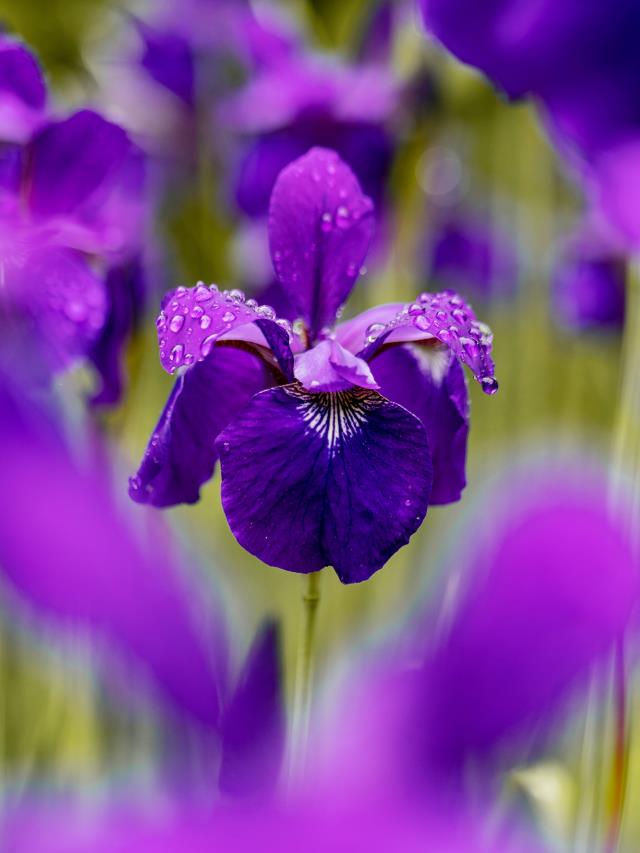By Beatrice Hawkins
Many years ago a lady I knew in Trangie NSW had an iris nursery. At the time I had nowhere to put them but added them to my wish list. As time went on she sent a specimen to an international competition in Florence, Italy and won her class with the bloom. After this Mrs. James retired and moved away but not before selling all her irises.
Some other friends bought a number from her and started their own business at Narromine selling a vast range of really spectacular specimens. They told me recently that they now have over 2000 varieties to choose from!
Some other plants went to Gympie but they did not like that climate and the people relocated to Bundarra in NSW. When I lived at Manilla I visited this nursery in October when the irises were in full bloom – spectacular!! Acres of the most amazing colours, it looked like a Monet painting.
Prior to visiting dedicated iris nurseries my only association with the plant was groups of “flag lilies” in deep purple or white, in paddocks where an old house had been. They were obviously very hardy and not attractive to livestock, native or introduced, as they survived with no care long after the house and garden had gone.
Last week I had the pleasure of once again seeing the descendants these hardy individuals, in a lovely collection of spectacular flowers in bloom in a garden here in Warwick.
The variety of colours seems to be unlimited and collecting, and even breeding them, can very easily become an obsession.
The name iris is of Greek origin and means rainbow and given the amazing range of forms and colours this is very appropriate. Apparently, the story goes, that when the Gods needed to contact people on earth they sent the goddess Iris to earth down the rainbow and everywhere her foot touched the earth the beautiful rainbow coloured flowers came up, hence the name of the flower.
Different colours have different meanings. Purple symbolises royalty and wisdom, yellow for passion, blue symbolises faith and hope and white, as with many flowers, purity.
The American state of Tennessee has chosen the iris as its state flower, it is the birth flower for February and is the flower to give on your 25th wedding anniversary.
With its wide range of colours and meaning there is one for most people in your life. Purple is appropriate for a parent or mentor, give yellow ones to a “significant other” and blue for someone who needs a little encouragement.
Irises are first recorded as garden flowers when in 1469BC King Thutmose 111 of Egypt saw them in Syria and brought them back to his garden. He was an avid gardener and apparently coveted irises as others, at the time, coveted gold. They quickly came to be revered in Egypt and to symbolise both the essence and renewal of life while the 3 petals of the flower were thought to represent faith, wisdom and valour. The rhizomes had medicinal uses and also were used in perfumes and incense for religious ceremonies.
They are relatively easy to grow in our climate given good drainage and full sun. Planting them fairly close together will provide a stunning display but will also mean they will need splitting up more often. This should be done in autumn before it gets too cold and they will flower the following spring. When planting it is important that the rhizomes are put in a shallow trench at a depth that allows the top of the rhizome to be exposed to the sun. They should be watered in immediately but once settled in really don’t require a lot of water. Over watering is a common problem with them as they do not like wet feet… good drainage is paramount.
A well balanced fertilizer is useful in early spring before blooming and about a month after but be careful not to get it on the exposed rhizome. Be sure not to use a high nitrogen fertilizer as this can cause soft growth and make the irises more susceptible to disease.
If you have a spot in the garden that fits these criteria I can think of nothing better to plant. They go well with a range of other flowers. Be careful – they can become addictive!!
Remember our water restrictions and use mulch to help retain what moisture we get and continue to pray for good soaking ongoing rain to replenish our subsoil moisture and then run off into our water supplies.
*This is an old article that has been digitised so our readers have access to our full catalogue.







